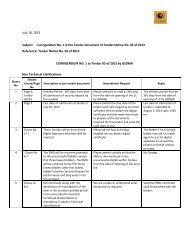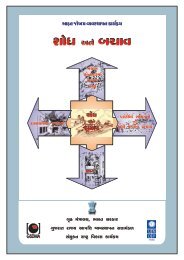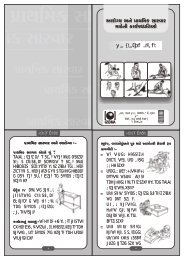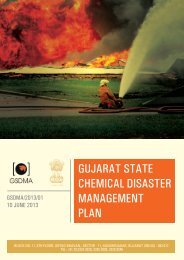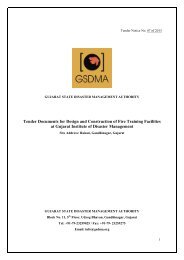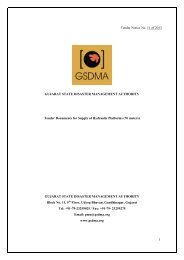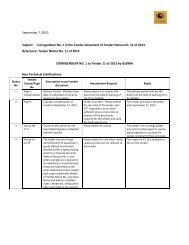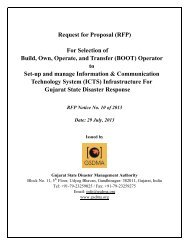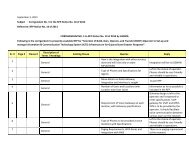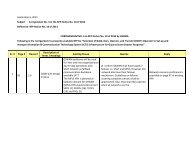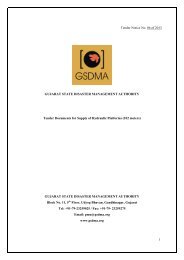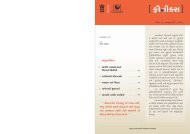Emergency Response Guidebook - Gujarat State Disaster ...
Emergency Response Guidebook - Gujarat State Disaster ...
Emergency Response Guidebook - Gujarat State Disaster ...
You also want an ePaper? Increase the reach of your titles
YUMPU automatically turns print PDFs into web optimized ePapers that Google loves.
GUIDE167Fluorine (Refrigerated Liquid)ERG2012ERG2012Fluorine (Refrigerated Liquid)GUIDE167POTENTIAL HAZARDSHEALTH• TOXIC; may be fatal if inhaled.• Vapours are extremely irritating.• Contact with gas or liquefied gas will cause burns, severe injury and/or frostbite.• Vapours from liquefied gas are initially heavier than air and spread along ground.• Runoff from fire control may cause pollution.FIRE OR EXPLOSION• Substance does not burn but will support combustion.• This is a strong oxidizer and will react vigorously or explosively with many materials including fuels.• May ignite combustibles (wood, paper, oil, clothing, etc.).• Vapour explosion and poison hazard indoors, outdoors or in sewers.• Containers may explode when heated.• Ruptured cylinders may rocket.PUBLIC SAFETY• CALL EMERGENCY RESPONSE Telephone Number on Shipping Paper first. If Shipping Paper notavailable or no answer, refer to appropriate telephone number listed on the inside back cover.• As an immediate precautionary measure, isolate spill or leak area for at least 100 meters (330 feet) inall directions.• Keep unauthorized personnel away.• Stay upwind.• Many gases are heavier than air and will spread along ground and collect in low or confined areas(sewers, basements, tanks).• Keep out of low areas.• Ventilate closed spaces before entering.PROTECTIVE CLOTHING• Wear positive pressure self-contained breathing apparatus (SCBA).• Wear chemical protective clothing that is specifically recommended by the manufacturer. It mayprovide little or no thermal protection.• Structural firefighters' protective clothing provides limited protection in fire situations ONLY; it is noteffective in spill situations where direct contact with the substance is possible.• Always wear thermal protective clothing when handling refrigerated/cryogenic liquids.EVACUATIONSpill• See Table 1 - Initial Isolation and Protective Action Distances.Fire• If tank, rail car or tank truck is involved in a fire, ISOLATE for 1600 meters (1 mile) in all directions;also, consider initial evacuation for 1600 meters (1 mile) in all directions.Page 274EMERGENCY RESPONSEFIRESmall Fire• Dry chemical, soda ash, lime or sand.Large Fire• Water spray, fog (flooding amounts).• Do not get water inside containers.• Move containers from fire area if you can do it without risk.Fire involving Tanks• Fight fire from maximum distance or use unmanned hose holders or monitor nozzles.• Cool containers with flooding quantities of water until well after fire is out.• Do not direct water at source of leak or safety devices; icing may occur.• Withdraw immediately in case of rising sound from venting safety devices or discoloration of tank.• ALWAYS stay away from tanks engulfed in fire.• For massive fire, use unmanned hose holders or monitor nozzles; if this is impossible, withdraw fromarea and let fire burn.SPILL OR LEAK• Do not touch or walk through spilled material.• If you have not donned special protective clothing approved for this material, do not expose yourselfto any risk of this material touching you.• Do not direct water at spill or source of leak.• A fine water spray remotely directed to the edge of the spill pool can be used to direct and maintain ahot flare fire that will burn the spilled material in a controlled manner.• Keep combustibles (wood, paper, oil, etc.) away from spilled material.• Stop leak if you can do it without risk.• Use water spray to reduce Vapours or divert Vapour cloud drift. Avoid allowing water runoff tocontact spilled material.• If possible, turn leaking containers so that gas escapes rather than liquid.• Prevent entry into waterways, sewers, basements or confined areas.• Isolate area until gas has dispersed.• Ventilate the area.FIRST AID• Move victim to fresh air.• Call 108 or emergency medical service.• Give artificial respiration if victim is not breathing.• Administer oxygen if breathing is difficult.• Clothing frozen to the skin should be thawed before being removed.• Remove and isolate contaminated clothing and shoes.• In case of contact with substance, immediately flush skin or eyes with running water for at least 20minutes.• Keep victim warm and quiet.• Keep victim under observation.• Effects of contact or inhalation may be delayed.• Ensure that medical personnel are aware of the material(s) involved and take precautions to protectthemselves.Page 275



